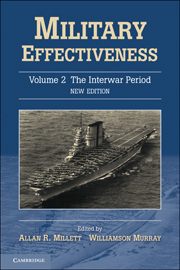Book contents
- Frontmatter
- Contents
- List of Contributors
- Introduction: Military Effectiveness Twenty Years After
- Maps
- 1 The Soviet Armed Forces in the Interwar Period
- 2 The French Armed Forces, 1918–40
- 3 The Military Effectiveness of the US Armed Forces, 1919–39
- 4 The British Armed Forces, 1918–39
- 5 Japanese Military Effectiveness: The Interwar Period
- 6 The Italian Armed Forces, 1918–40
- 7 German Military Effectiveness between 1919 and 1939
- 8 Military Effectiveness of Armed Forces in the Interwar Period, 1919–41: A Review
- Index
4 - The British Armed Forces, 1918–39
Published online by Cambridge University Press: 05 June 2012
- Frontmatter
- Contents
- List of Contributors
- Introduction: Military Effectiveness Twenty Years After
- Maps
- 1 The Soviet Armed Forces in the Interwar Period
- 2 The French Armed Forces, 1918–40
- 3 The Military Effectiveness of the US Armed Forces, 1919–39
- 4 The British Armed Forces, 1918–39
- 5 Japanese Military Effectiveness: The Interwar Period
- 6 The Italian Armed Forces, 1918–40
- 7 German Military Effectiveness between 1919 and 1939
- 8 Military Effectiveness of Armed Forces in the Interwar Period, 1919–41: A Review
- Index
Summary
Introduction
The basic problem in judging the effectiveness of Britain's military institutions between the two world wars lies in the catastrophes of 1940 and 1941. It is almost unavoidable that inadequacies so glaringly exposed in those dismal years should influence judgments on the institutions that had evolved military policies in the interwar period. Yet one must temper such judgments with a sense of the limited framework which society and the political atmosphere imposed on Britain's military institutions. Moreover, from our perspective the coming war, the Second World War, is of consuming interest, but for those who set policy in the interwar period, as well as for popular opinion, the dominating concern lay in the horrors of the last war.
This last point deserves emphasis. In the 1920s it was difficult to foresee a major war against any of Britain's potential opponents. In the mid to late 1930s memories of the last war so dominated the thinking of politicians and population alike that rearmament in the face of terrible dangers was tardy, ill conceived, and in general unrealistically minimized (especially for the army). The initial reaction to victory in 1918 had been relief and pride in British military accomplishments. By the 1920s, however, popular attitudes, particularly in the upper and educated classes, had shifted to a fundamentally pessimistic assessment of ‘victory.’ It became commonplace to argue that little separated the lot of the victors from that of the defeated (an assessment not shared by those across the North Sea).
- Type
- Chapter
- Information
- Military Effectiveness , pp. 98 - 130Publisher: Cambridge University PressPrint publication year: 2010



